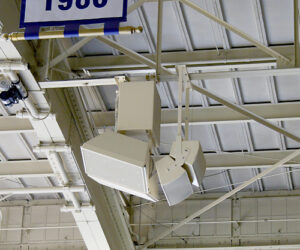The textbook definition of a microphone is a transducer that converts acoustical energy (sound waves) into electrical energy. Basically, a sound wave hits a diaphragm or membrane and causes it to vibrate. These vibrations are turned into electricity and flow out to the console.
Mics are usually categorized by the conversion process that’s used to turn acoustical energy into electricity. The most common type used on live stages are dynamic designs that work on the electromagnet principle where a coil of wire is attached to the diaphragm and moves by a magnet, creating electricity as the sound waves push against the diaphragm.
Dynamics can be very rugged and resilient to rough handling, but because there’s added mass attached to the diaphragm, they may not respond as quickly to changes in sound pressure as other types.
Condensers have gained in popularity in the live world, with many newer models robust enough to withstand abuse. They have two plates with a voltage between them. One plate is made of very light and flexible material, and acts as the diaphragm. The diaphragm vibrates when struck by sound waves, changing the distance between the two plates, which in turn changes the capacitance, producing an electrical signal.
Condenser diaphragms are not connected to a coil mass. They respond to transients and higher frequencies very well, enhancing sensitivity and the ability to capture high-frequency detail with more accuracy. A variation of the condenser is the electret, which uses a fixed charge on one of the plates. Note that condensers require a power source (phantom power or batteries).
The vast majority of vocal mics are unidirectional, with pickup patterns including cardioid, supercardioid and hypercardioid. In general, they reject sounds from directions other than the front (at various degrees), and this is highly desirable given all of the noise on a typical stage as well as from the house.
Cardioids are more forgiving to a singer’s technique and the angle at which the mic is addressed. Supercardioids are more focused to favor sounds from the front and have greater attenuation at their sides – about 10 dB – exhibiting minimum sensitivity 140 to 150 degrees off-axis, with a minor secondary response lobe at their rear. Hypercardioids are even slightly more focused and distinguished by minimum response 110 to 120 degrees off-axis at the expense of a slightly larger rear lobe.
Another way mics are categorized is by their intended use on vocals or instruments. Many sound good in either application, but higher-end vocal models often have added features to benefit vocals. One phenomenon that comes into play is proximity effect – as a singer gets right up on the mic, the lower frequencies become more pronounced. Many premium vocal mics address this issue with acoustic tuning, low-cut switches, or electronic processing so the singer’s voice stays more consistent.
Vocal mics should be designed to deal with “pops and plosives,” the breath noises that happen when a singer uses a hard consonant like a P or B. Mics designed for live performance have windscreens, but the better vocal models tend to use multi-stage or layered screens to reduce the problem. Handling noise is another issue. As it’s moved around, noise from the mic body can get transmitted to the capsule. Capsule isolation to curtail this issue is a hallmark of well-designed units.
Mics specifically designed for vocals should have a frequency response tailored for the human voice. Some models will offer a reduced frequency range while others may add a boost or cut. When it comes to vocal mics, it’s not necessarily always about having a flat-graph response, it’s about making the voice sound great in the mix.
Enjoy our Photo Gallery Tour of a range of dynamic and condenser mics for vocals.
Senior contributing editor Craig Leerman is the owner of Tech Works, a production company based in Las Vegas.
















